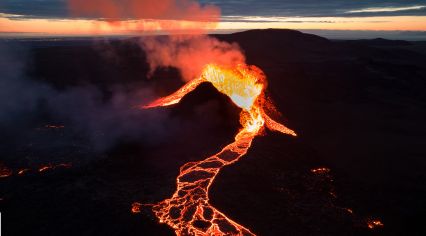The recent volcanic eruption in Iceland, occurring for the third time in recent months, has brought significant concerns to the already damaged fishing town of Grindavik and the renowned tourist attraction, the Blue Lagoon spa. Here are the key points from the situation:
- Location and Impact: The eruption is happening on the Reykjanes peninsula, approximately 40 kilometers from Iceland’s capital. Lava is flowing from a 3-kilometer crack and heading west, away from Grindavik. However, the eruption poses risks to infrastructure such as the power plant and Blue Lagoon spa, as well as the road between Keflavik and Grindavik.
- Evacuations and Precautions: Hotels at the Blue Lagoon spa site were evacuated, and earth barriers have been constructed to mitigate lava flows. Despite the volcanic activity, flights in and out of the country remain unaffected.
- Geological Activity: The Reykjanes peninsula had been dormant for about 800 years until seismic activity began in 2020. Since then, there have been six eruptions, including the current one. Iceland’s geological activity is attributed to its location between tectonic plates, with about 30 volcanic systems and over 600 hot springs.
- Challenges and Predictions: The eruption represents significant damage to Grindavik, with roads, power lines, and water pipes affected. Authorities had built barriers to protect the town, but the ongoing volcanic activity is difficult to predict and expected to continue for years.
- Historical Context: Grindavik’s destruction is described as the worst volcanic damage in Iceland in 50 years, with most eruptions typically occurring in uninhabited areas. The 1973 eruption in the Westman Islands is referenced as another significant event in Iceland’s history.
- Comparison to Previous Eruptions: Unlike some past eruptions, fissure eruptions like the current one produce minimal ash and do not significantly disrupt air travel. The eruption of Eyjafjallajokull in 2010 is cited as an example of a more disruptive event, which led to widespread flight cancellations and affected millions of people across Europe due to ash clouds.
Here are some additional details about the recent volcanic eruption in Iceland:
- Timeline of Eruptions: The recent eruption marks the third occurrence in recent months on the Reykjanes peninsula. Seismic activity in the area began in 2020, leading to six eruptions, including the ongoing one. This increased volcanic activity contrasts with the peninsula’s long dormancy period, which lasted about 800 years.
- Magnitude of Tremors and Earthquakes: Grindavik has experienced thousands of tremors and several earthquakes, contributing to the destruction of infrastructure such as roads, power lines, and water pipes. These seismic events have also created potentially dangerous cracks and crevasses, posing risks to residents and visitors.
- Environmental Impact: While the current fissure eruption produces minimal ash, it has significant implications for local ecosystems. The lava flows can destroy vegetation and alter the landscape, affecting wildlife habitats and geological formations in the area. Furthermore, the release of gases and chemicals from the volcanic activity may have environmental consequences.
- Response and Mitigation Efforts: Icelandic authorities have implemented various measures to address the eruption’s effects on communities and critical infrastructure. Evacuations, construction of earth barriers, and ongoing monitoring by the Met Office aim to minimize risks and ensure public safety. Additionally, efforts to assess and repair damaged infrastructure are underway to mitigate the eruption’s economic and social impact.
- Long-Term Predictions and Preparedness: Scientists at the Met Office emphasize the unpredictable nature of volcanic activity, particularly in regions like Iceland with complex geological dynamics. While the current eruption’s trajectory is monitored closely, the potential for future eruptions and seismic events underscores the importance of long-term preparedness strategies and investment in disaster resilience.
Overall, the situation highlights the ongoing geological activity in Iceland and the challenges it poses to local communities and infrastructure, emphasizing the need for continued monitoring and preparedness measures.
Read More at BE UPDATED!



Pingback: Kate Garraway's Heartfelt Return To Good Morning Britain - BE UPDATED
Pingback: Cameron Heyward Wins Walter Payton Man Of The Year Award 2024 - BE UPDATED
Pingback: Florida Earthquake: Largest Ever Recorded In History
Pingback: Lunar New Year 2024: Year Of The Dragon - BE UPDATED